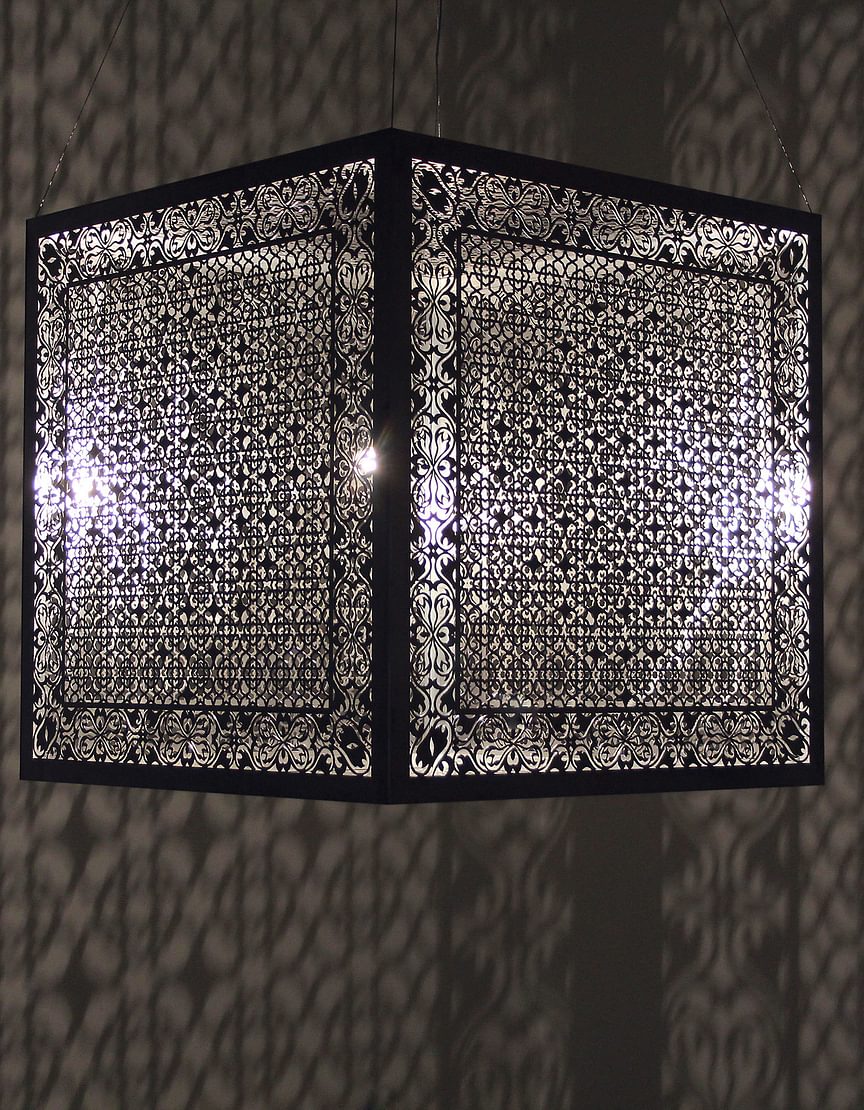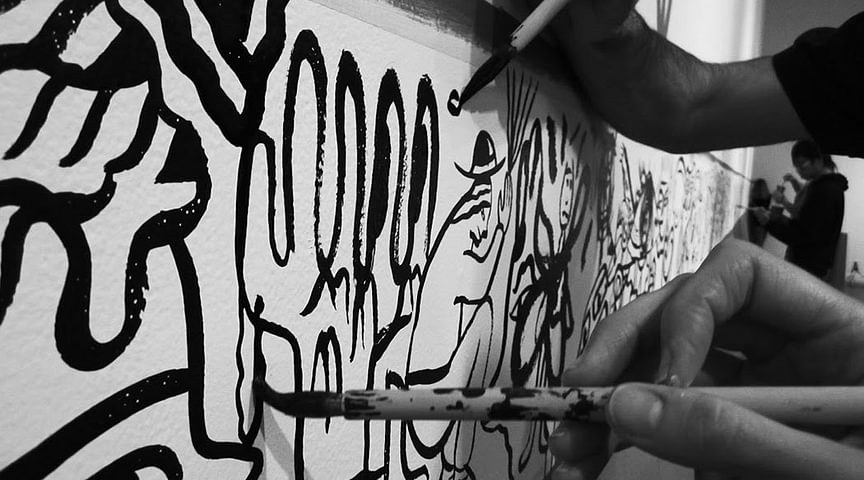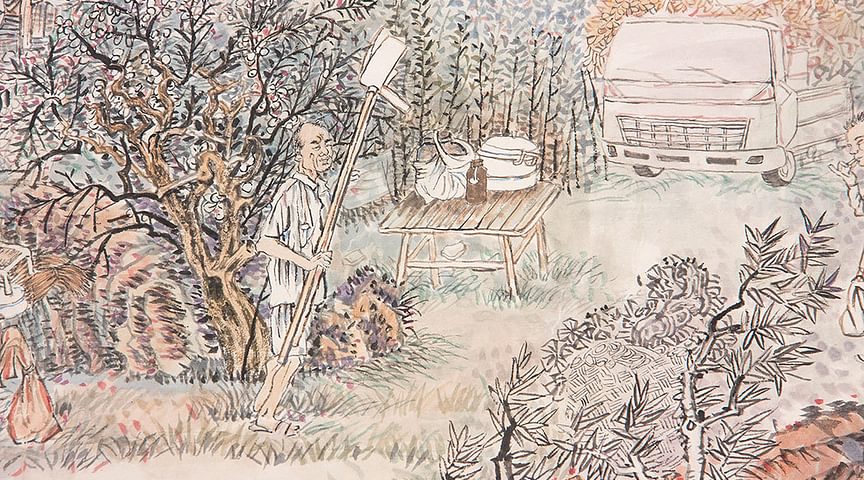
January 08, 2018
Convergence examines merging of Eastern and Western aesthetic traditions
Features new and recent Work by Anila Quayyum Agha, Lalla Essaydi, Yun-Fei Ji, and Fred H. C. LiangExtending the Addison Gallery of American Art’s exploration of what it means to be an American today, Convergence unites the work of four contemporary artists from around the world whose practice has been shaped by their heritage and migration to the United States. On view from January 27 through July 31, 2018, the exhibition features new and recent work by Anila Quayyum Agha, LallaEssaydi, Yun-Fei Ji, and Edward E. Elson Artist-in-Residence Fred H. C. Liang, who draw upon techniques and histories that blend East and West, traditional and contemporary. From a site-specific installation employing ancient paper-cutting techniques to explore Chinese migration, to photo-based works that subvert 19th-century European depictions of Arab women, Convergence provides multiple viewpoints for examining the nature of art making and identity in today’s globalized world.
Part of a series of initiatives addressing diverse influences in American art, Convergence is accompanied by a participatory project with Sumi Ink Club. Founded by L.A.-based artists Sarah Rara and Luke Fischbeck, Sumi Ink Club invites the public to create an immersive work using age-old calligraphic and brush techniques. Dedicated to fortifying social interactions through artistic collaboration, Sumi Ink Club will lead three open drawing sessions on January 20, 21 and 24 that will result in a finished wall mural to be unveiled at the opening reception on January 26. The installation will offer insight into Mark Tobey’s use of sumi ink during the concurrent major retrospective of his work at the Addison. On view through March 11, 2018, Mark Tobey: Threading Light reappraises a vanguard figure of mid-century American modernism, whose work was deeply influenced by his travels to Asia. In addition to participating in the creation of the sumi ink installations, visitors will be able to view Tobey’s experimentations with the medium, alongside other works that demonstrate his distinct incorporation of Eastern and Western visual vocabularies.

“We are thrilled to provide a platform for such a talented group of artists, whose hybrid forms transcend national boundaries and reflect the diversity of creative voices that are shaping today’s contemporary art field,” said Judith Dolkart, the Mary Stripp and R.Crosby Kemper Director of the Addison Gallery of American Art. “As home to one of the most comprehensive American art collections, we have an incredible opportunity to engage students and the public in ways that advance the national dialogue around American identity in context of the full sweep of U.S. history represented in our holdings. We look forward to sharing these artists’ stories with our visitors, and activating our galleries with their creativity.”
Located on the campus of Phillips Academy in Andover, MA, the Addison Gallery of American Art will dedicate an entire gallery to each of the participating artists in Convergence. Installations on view will include:
- Created on campus as part of the Addison’s artist residency program, an immersive installation comprised of drawings and sculpture by Fred H. C. Liang (b. Wuhan, China, 1964) that explores the history and global impact of Chinese migration as they intersect with his own personal history. Liang’sancestors are from Dehua, in the Fujian province close to Xiamen, an area known for distinct white porcelain products produced from the Ming dynasty to the present day and a popular Chinese export beginning in the 18th century.The native people of Dehua are referred to as “Hakkas,” and Liang’s family still speaks the native language. To inform his installation, Liang traveled to Dehua to further research the history and culture of his Hakka heritage. Translated as “visitors” or “guests,” Hakka refers to the Chinese people who migrated from north to south China during the Song Dynasty and later to other parts of the world in search of economic opportunity. Created on-site at the Addison’s artist-in-residence studio, Liang’s installation combines the Blanc de Chine (or Chinese White) porcelain native to Dehua, and jianzhi, the traditional Chinese art of cut paper, in works that examine the movement, appropriation, and transformation of cultural ideas, objects, and peoples.
- Hidden Diamond (2016), an installation by Anila Quayyum Agha(b. Pakistan, 1965), which uses light and cast shadows to transform the gallery into a place reminiscent of Islamic sacred spaces dense with geometric ornamentation and pattern. The work is part of a series inspired by Agha’s visit to the Alhambra in Granada, Spain, a space that recalled for the artist sacred places in her native Pakistan from which she was excluded because of her gender. Suspended from the ceiling, light shines from within a perforated cube and casts intricately patterned shadows that cover the gallery walls, ceiling, floor, and museum visitors. With no clear boundaries, the moving visitors change the nature of the pattern as they walk through its dense and enveloping silhouette. Reflecting the conflicted feelings of wonder and alienation that originally inspired the piece, Hidden Diamond becomes a crossroads in which tradition and modernity, light and shadow, public and private, static and dynamic, manage to converge and converse—a contemplative space that is open to all.
- A selection from Lalla Essaydi’s (b. Morocco, 1956) photographic series Les Femmes du Maroc, the title of which is adapted from Eugene Delacroix’s iconic painting, Les Femmes d’Algiers (1834). The latter, while based on Delacroix’s travels in North Africa, is a fictional vision of languorous women in an opulent harem. Such paintings coincided with the 19th-century European colonization of much of the Arab world and fostered a view of the Middle East as a sensual paradise of permissive women, rich colors, and exotic tastes. Essaydi takes these Orientalist paintings as a point of departure from which to unmask the fetishistic and formulaic depictions of Arab women by Western artists and expose the dynamics of colonial politics. In her large-scale photos, she retains the compositions, gestures, and costumes of the 19th-century paintings, removes all male figures, drains most color, and drapes the bodies and surfaces in white fabric. The artist inscribes Arabic calligraphy onto the backdrops, floor, drapery—even her model’s skin—presented within a shallow, stage-like space. In Islamic cultures calligraphy is a male art form, used primarily to transcribe the Qu’ran and sacred literature; however, in Essaydi’s work, the texts inscribed onto the visible surfaces of her work—musings on personal freedom, cultural and individual identity, memory and communication taken from her personal journals—are applied with henna, a tradition associated with women.
- A selection of works by Yun-Fei Ji (b. China, 1963), who draws upon the thousand-year-old practice of Chinese scroll painting, employing ink on paper as his primary medium and landscape as his central subject. Ji emphasizes the critical relationship between the land of China and its people, and how that balance is being challenged by social, ecological, and economic shifts. His compositions are inspired by his own fieldwork in rural China, where entire villages had to relocate to make way for ambitious infrastructure projects such as the Three Gorges Dam, and where climate change has compromised the natural environment. The resulting artworks are populated by present-day figures inhabiting land in various stages of transition; alongside the villagers, ghosts of ancestors and animal-like folkloric figures act as powerful reminders of the longstanding cultural traditions at risk. Among the works on view is a 40-foot hand scroll, The Move of the Village Wen (2012), which depicts a fictional hamlet inspired by the stories of the forced migrations he has witnessed. As the narrative in this work progresses from right to left, what begins as a bucolic scene is disrupted by environmental and communal upheaval, and ultimately enters an unfamiliar, otherworldly terrain. Ji’s detailed and empathetic treatment of his subjects reflects the responsibility he feels to reveal their hardships to international audiences and to remind viewers that the victims portrayed in these visual narratives are not merely statistics of distant plights, but individuals who warrant urgent attention.

Headline Image
Anila Quayyum Agha
Hidden Diamond
2016
Lacquered steel and halogen bulb
36 x 36 x 36 inches
courtesy of the artist
© Anila Quayyum Agha





